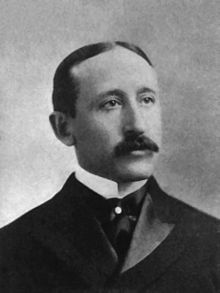James Ewing (pathologist)

James Stephen Ewing (
Life
James Ewing, was born in 1866 to a prominent family of Pittsburgh. When he was 14 he was diagnosed with
In 1910, Ewing had approached
In 1919 Ewing published the first edition of Neoplastic Diseases: A Text-Book on Tumors.[7] The book, which is translated into numerous languages, becomes a cornerstone of modern oncology by establishing a systematic and comprehensive basis for diagnosing human cancer.[3] In 1921 he published a paper detailing a type of osteoma which later received his name: Ewing sarcoma.[2][8][9]
In 1931 Ewing was formally appointed president of the hospital[2] and was featured on the cover of Time Magazine as "Cancer Man Ewing";[10] the accompanying article described his role as one of the most important cancer doctors of his era.[11] He worked at Memorial Hospital until his retirement in 1939.[2] In 1942, he was presented with the prestigious gold-headed cane award of the American Association of Pathologists and Bacteriologists.[12]
Under his leadership, Memorial became a model for other cancer centers in the United States, combining patient care with clinical and laboratory research,[13] and it was said of him that "The relationship of Ewing to the Memorial Hospital can best be expressed in the words of Emerson, 'Every institution is but the lengthening shadow of some man.' Dr. Ewing is the Memorial Hospital".[3]
In 1951, The James Ewing Hospital, a 12-story building on First Avenue between 67th and 68th Streets, opened; it was intended to treat cancer among New York City's poor.[14]
Bibliography
A collection of his correspondence is held at the National Library of Medicine.[15]
- Zantinga, AR; Coppes, MJ: James Ewing (1866-1943): "the chief". Medical and Pediatric Oncology, New York, 1993, 21 (7): 505-510.
- Huvos, AG: James Ewing: cancer man. Annals of Diagnostic Pathology, April 1998, 2 (2): 146-148.
- Ewing, J: Clinical pathology of Blood: A Treatise on the General Principles and Special Applications of Hematology. Philadelphia and New York, 1901.
- Ewing, J: Neoplastic Diseases: A Textbook on Tumors. Philadelphia, W. B. Saunders, and London, 1919. Fourth edition 1940.
- Ewing, J: Causation, Diagnosis and Treatment of Cancer. Baltimore, 1931.
- Ewing, J: Blood. Philadelphia. 1910.
References
- ^ Simon Cotterill for Cancer Index. About James Ewing, 1866 - 1943 Last modified: 16/03/99
- ^ PMID 22207564.
- ^ a b c d e f g h James B. Murphy James Ewing Biographical Memoir National Academy of Sciences Washington D.C., 1951.
- ^ The Register (Volumes 15-18 ed.). Cornell University. 1915. p. 110.
- ^ Ewing, James & Beebe, S. P. (1906). A study of the so-called infectious lympho-sarcoma of dogs. Journal of Med. Research. 10:209.
- ^ Beebe, S. P., and James Ewing. (1906). "A study of the biology of tumour cells. "The British Medical Journal": 1559-1560.
- ^ Ewing, James. (1919). Neoplastic Diseases: A Textbook on Tumors. Philadelphia, W. B. Saunders, and London. Fourth edition 1940.
- ^ Ewing, James. (1922). Neoplastic diseases: a treatise on tumors. WB Saunders Company.
- PMID 20316532.
- ^ Time Magazine Cover, January 12, 1931
- ^ Cancer Crusade. Jan 12, 1931. Time Magazine 17(2):26
- . Retrieved 2024-02-24.
- S2CID 31026667.[permanent dead link]
- ^ New developments in cancer, CA: A Cancer Journal for Clinicians, Volume 1, Issue 2, pages 64–67, January 1951.
- ^ Manuscripts at NLM
